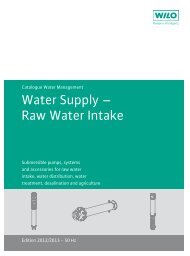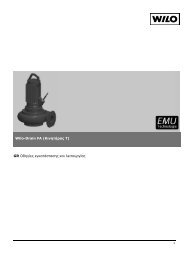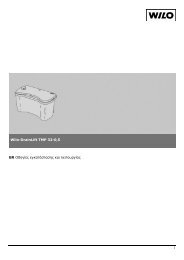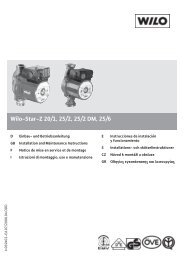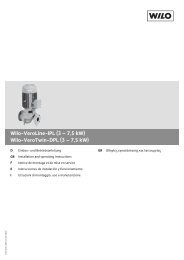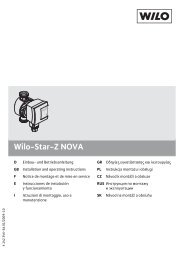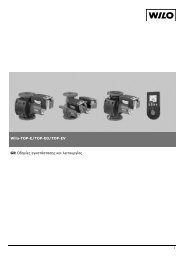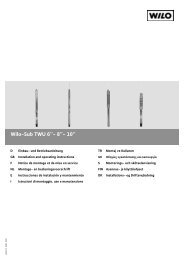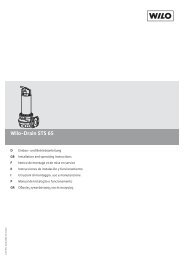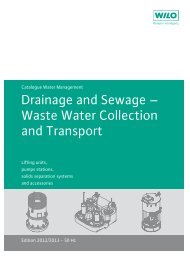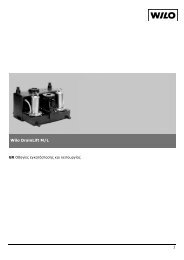'UDLQDJH DQG 6HZDJH À :DVWH :DWHU 7UDQVSRUW ... - WILO
'UDLQDJH DQG 6HZDJH À :DVWH :DWHU 7UDQVSRUW ... - WILO
'UDLQDJH DQG 6HZDJH À :DVWH :DWHU 7UDQVSRUW ... - WILO
Create successful ePaper yourself
Turn your PDF publications into a flip-book with our unique Google optimized e-Paper software.
Planning guideBasic electric principlesStarting currentThis is the current which is required during the start-up operation ofa machine to overcome friction losses and starting torques. Thestarting current can be up to seven times that of the nominal current,depending on the type of start-up. When there is instability in theelectric mains or for larger motors, corresponding devices must beprovided to reduce the starting current. These could be soft starters,frequency converters, etc. Designing the motor as a star-delta motorcan already reduce the starting current.ATEXSee “Ex protection” chapterOperating modes (in acc. with DIN EN 60034-1)See “Operating modes” chapterIndividual run signalIndicates the fault of the individual pump and demonstrates an exactevaluation method for building control systems.Explosion protectionExplosion protection has been modified in the EU. Since July 1, 2003,the European directive 94/9/EC has applied for explosion protection.The modifications generally have to do with the fact that the entireunit (not only the electrical part) has to be tested and certified takingexplosion-protection aspects into account. A definition concerningthe zones in which explosion protection is to be provided is theresponsibility of the operator. The units identified by Wilo as explosion-protectedare designed for Zone 1, Group II, Category 2, i.e. for ahigh degree of safety and for the cast that potentially explosiveatmospheres can be expected.Furthermore, a few series are also approved according to theAmerican FM directive.For further information, see the “Ex protection” chapter.Ex-rated cut-off relayUsing ex-rated cut-off relays, float switches can also be used inpotentially explosive environments (Zone 1 for fluids containingfaeces). These relays reduce the flowing current to a magnitudewhich doesn't cause sparks, even in the event of an error, whichwould cause the fluid or its surroundings to ignite.FMSee “Ex protection” chapterMotor protectionFor a safe operation of a motor, this must be protected againstunacceptable high warming. Such an unacceptable warming canresult from faults which increase the motor current and strongly heatup the motor:• Overload• Phase failure• Undervoltage• BlockingThese faults can be recognised by an overload relay or a motor protectionswitch which then switch off the motor. Overload relays andmotor protection switches may only be set to the maximum nominalcurrent of the motor.Overload relayPrinciple of operation:The thermal protection is ensured by bimetals which heat up as themotor current flows via heating windings. For every conductive lineto the motor, a separate bimetal with corresponding heating windingis provided. If the power consumption of just one motor winding exceedsthe predefined value over several seconds, the generated heatwill deform the bimetal which then triggers the latch and switches offthe motor contactor. Also, if a phase fails (irregular heating of thebimetal strips), the motor is switched off after a short period of time.After a thermal triggering has taken place, the switch can only beswitched on again after the bimetals have cooled down sufficiently.Overload relays don't switch off the motor directly, they have a contactfor relatively low switching frequencies. This contact activates acontactor which then switches the motor off in the event of a fault. Incontrast to the motor protection switch, an overload relay does nothave a short-circuit trip. This is why safety fuses should be installedin the supply line for one or several motors which are protected byoverload relays. Moreover, the reactivation of overload relays can bedone manually or automatically. The reactivation should be donemanually in order to avoid a permanent switching on and off whenthere is a fault.Motor protection switchWith motor protection switches, motors can be switched on and offunder normal operating conditions. The thermal triggering is basedon the principle of the overload relay. However, the operator is in aposition to switch off the motor during operation or in the event offault. Moreover, most motor protection switches have an additionalmagnetic quick triggering which protects the downstream line andthe motor against short circuits. With lower currents, these switchesare short-circuit proof, i.e. a back-up fuse may not be required.Other faults which lead up to an increased heating-up:• Dry-running of motors that may only operate in a submerged state• Unacceptable high fluid temperatures / ambient temperature• Unacceptable running times in short-term operationThese faults do not influence the current consumption of the motorand can therefore not be recognised by the upstream overloadprotection! For such faults, temperature sensors are used which aredirectly imbedded in the component to be protected (motor winding).Protection measures (DIN VDE 0100-410)Protection classes:(DIN EN 50529 / VDE 0470 Part 1)The type of protection which a housing offers to e.g. protect againstdirect contact, is defined by the IP (International Protection) codes.This is made up of the “IP” and two digits (e.g. IP 54).First digit:• Protection of people against contact with dangerous parts• Protection of the equipment against ingress of solid foreign matterSecond digit:• Protection of the equipment against the ingress of water18 Wilo Water Management catalogue – 50 Hz – Drainage and sewage – Waste water transport and dewatering – Edition 2012 – Subject to change without prior notice




